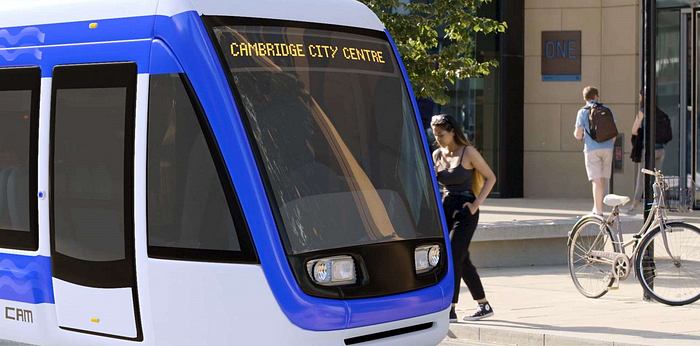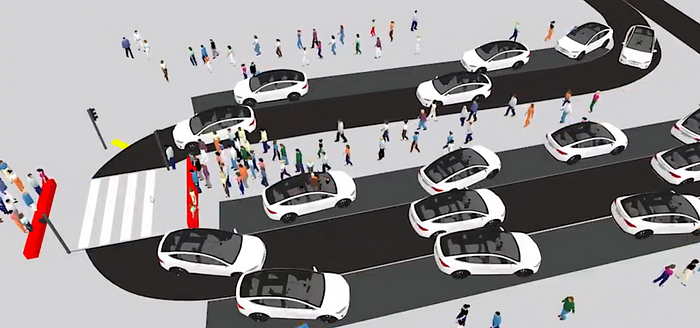Is Cambridgeshire’s New Metro All It’s Cracked Up to Be?

If it isn’t autonomous, and it isn’t a metro system, then what exactly is the Cambridgeshire Autonomous Metro? GARETH DENNIS dives under the hood of this strange project.
A version of this article also appeared in Issue 918 (18 November 2020) of RAIL magazine. Subsequently, the Cambridgeshire Autonomous Metro was cancelled when Mayor James Palmer was voted out on 6 May 2021. There are no plans to revive it.
Have you heard the word “gadgetbahn” before? It is a portmanteau coined to describe transport proposals that, to all intents and purposes, ought to be delivered using proven railway technology and yet go out of their way to be anything but a railway. Typically, such systems are intended to distract from or be at the expense of investment in proper, functional public transport.
In the last week or two, a couple of significant gadgetbahn projects have been hitting the headlines again, and one of them can tell us a lot about the future of the other.
Led by Mayor James Palmer, the Cambridgeshire & Peterborough Combined Authority are continuing to progress their tunnelled bus system, bizarrely named the Cambridgeshire Autonomous Metro or CAM for short, which promises to transform transportation in the region.
Meanwhile, over in Las Vegas, Elon Musk’s aptly named Boring Company has been updating the details of its Loop system (not to be confused with the high-speed vacuum maglev gadgetbahn called Hyperloop), which is reaching the end of its initial construction phase.
Originally proposed as a tunnelled rapid transit system using platoons of autonomous people movers, the latest announcements and planning submissions confirm that it is now little more than a lane of traffic buried underground, with a fleet of regular Tesla cars shuttling a few people between stops. Even the much-celebrated autonomy has been dropped, with each vehicle requiring a permanent driver. And the capacity of this system? Merely a fraction of the promised figures.

This is a useful bit of foresight as to what happens when the glamour of a technology-heavy solution pushes the rather more mundane matters such as “how many passengers will it carry” or “will it actually work” to one side. As I’ve heard it neatly put, “nodes before modes” — in other words, understand what a transport system needs to do and then pick an appropriate type of system that fits. Not the other way around.
Unfortunately, the CAM proposals typify the opposite approach.
Even the name itself is all about the technological whizzgiggery rather than describing the transport network independent of how it moves people about. But this is only the tip of the iceberg.
In the technical documentation that has been released so far, there are only passing references to the system’s potential autonomy. For example, that “CAM presents the opportunity to adopt rapidly emerging autonomous vehicle technology” despite it not being “dependent or in any way predicated on autonomous operation”. Furthermore, its “autonomous” features are further undermined by the fact that “driver costs are included, as CAM is expected to operate with drivers on ‘day one’ and move towards autonomous operation at a future date” — hardly a ringing endorsement for a component of the system that merits being part of its name.
In any case, making a huge fuss about autonomy betrays a lack of knowledge of the public transport sector — for example, the Docklands Light Railway has been “autonomous” for decades.
So it isn’t autonomous. Is it a metro?
In the UK, the term metro has had its meaning substantially diluted over the years to refer to anything with fixed infrastructure (Manchester Metrolink is not a metro; neither is the West Midlands Metro). However, to avoid politicians being able to fob off those parts of the country outside of the M25 which suffer a substantial public transport investment defecit, we ought to know the threshold at which the term usefully applies and hold them to it.
To do this, we look at system capacity. This is the total number of people a transport system can move in one direction in an hour. In other words, the maximum capacity of the vehicles it uses multiplied by the maximum frequency of service. It is measured in “passengers per hour per direction” or “pphpd”.
Globally, “metro” refers to segregated public transport infrastructure that has a system capacity greater than 10000pphpd (or 20000pphpd according to some authorities). This invariably requires a railway system, i.e. steel wheels on steel rails. In the UK, the only true metro system outside of London is the Tyne and Wear Metro, and even this stretches the definition (it is not entirely segregated, and its system capacity is only marginally above the 10000pphpd mark). By comparison, London Underground’s Victoria line has a system capacity of 36000pphpd.
To work out the likely system capacity of CAM, we need to dig into the details of the proposal a bit.
As is common with urban transport networks, CAM is formed of several branches feeding into a higher-density core. 12 services per hour in each direction are proposed to operate on the branches resulting in 36 services per hour in each direction through the “core” city centre section.
That’s incredibly intensive. Medium capacity system (light rapid transit) frequencies don’t exceed 16 trains per hour (tph) in the UK, and only in 2018 was the Victoria line upgraded to manage 36tph (making it one of the highest frequency metro systems in the world).
To make comparisons between CAM and a medium capacity system (MCS), we have to assume the vehicles they use. For CAM, I’ll use the Irizar ie tram which is the same vehicle that is favoured in the CAM documentation. It’s basically an expensive bendy bus designed to resemble a conventional tram.
For our comparator MCS vehicle, I am going to use the CAF Urbos 3, a light rail vehicle used by the Edinburgh Trams and many other systems worldwide. It follows a fairly common design and is easily capable of dealing with narrow/steep streets. The Urbos 3 also doesn’t have to lunk its own power supply around so is 50% lighter on its axles than the bus, despite having a 60% higher passenger capacity.

These two vehicles give us a maximum system capacity for the proposed network. Looking at the high-density core, CAM gives a capacity of 5580pphpd. An MCS with the same service pattern would give 9000pphpd. With a capacity around half that of the Tyne and Wear Metro, CAM decidedly is not a “metro” system.
This alone isn’t a reason to dismiss the proposals, though.
If we are going to assess the value of using “trackless” (i.e. tarmac only) bus-trams, we need to consider the annual tonnages that the infrastructure would have to sustain to deliver the service specification.
Just as I do in my day job when deciding how tough a railway needs to be, we measure this in equivalent million gross tonnes per annum (EMGTPA). Through its core, CAM would reach an annual tonnage of 4.8EMGTPA.
Edinburgh’s MCS has an annual tonnage of just under 2EMGTPA, and other systems have figures up to 4EMGTPA. To put it another way, if annual tonnages are at 2EMGTPA or above, then the whole life cost analysis generally favours steel wheels on steel rails.
Steel on steel also gives significant energy efficiency benefits, as does the increased passenger capacity and reduced complexity (thus maintenance requirements) of light rail vehicles, particularly if they are externally powered. A conservative estimate gives an operational emissions advantage of around one third for trams compared to intensive bus-only systems.

We’ve established that it isn’t autonomous, that it isn’t a metro, and that it isn’t a particularly efficient system either. How on earth has CAM got this far, then?
CAM was selected in an options appraisal process that concluded back in January 2018, undertaken, I’ll add, by the same consultancy that proposed it in the first place. CAM was selected over a more conventional MCS because it supposedly offers the same benefits as an MCS but for a third of the cost.
Around a year later the consultancy in question then published their strategic outline business case, in which the cost of CAM had increased from an optimistic £1.7bn to a more reasonable £4.5bn. This was precisely the cost of the MCS system that they had analysed in the options selection report (with a more reliable estimation as it was based on proven engineering), completely undermining the decision made in that report.
Thus the selection of CAM was flawed from the start.
And what of its costs?
CAM’s eye-watering project costs, mostly from its required tunnelling, seem to be palatable because CAM doesn’t interrupt the flow of road traffic through Cambridge city centre. The unit cost of €92m/STK (single track kilometre) is far greater even than Crossrail’s (including its latest budget rises), which is baffling if you compare the specification of the two systems.
It certainly doesn’t compare favourably with the calamitous first phase of the Edinburgh Trams (€32m/STK), or the very complex Manchester Metrolink 2CC project through Manchester’s city centre (€74m/STK), or even the latest figures for High Speed 2 (€78m/STK) which will include several massive hub stations.

Even if Cambridgeshire can justify its own mass transit system, excluding cars from the city streets and enabling a segregated MCS would be much quicker to build and more cost-effective, even if short lengths of tunnel were required at tight spots.
In the meantime, removing city centre parking, increasing charges for on-street parking and investing heavily in segregated bus and cycling infrastructure would provide congestion relief and better public transport options. If nothing else, COVID has reminded us that the only way to reduce congestion is to reduce the number of private vehicles on the road.
Which brings us back to Musk’s underground linear car park, a.k.a. the Loop. If we can learn anything from this folly it is to avoid letting the tail wag the dog: a transport system should be defined by its purpose, not by its technology.
For once, Elon Musk can actually teach us something about transport. Despite the big talk, CAM is a gadgetbahn that should be pushed to one side in favour of a more straightforward and conventional tram system.

